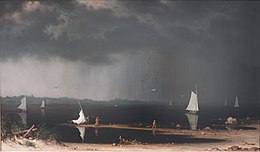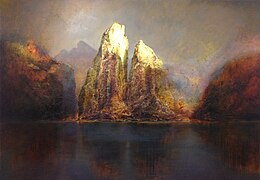
Impressionism was a 19th-century art movement characterized by relatively small, thin, yet visible brush strokes, open composition, emphasis on accurate depiction of light in its changing qualities, ordinary subject matter, unusual visual angles, and inclusion of movement as a crucial element of human perception and experience. Impressionism originated with a group of Paris-based artists whose independent exhibitions brought them to prominence during the 1870s and 1880s.

Visual art of the United States or American art is visual art made in the United States or by U.S. artists. Before colonization, there were many flourishing traditions of Native American art, and where the Spanish colonized Spanish Colonial architecture and the accompanying styles in other media were quickly in place. Early colonial art on the East Coast initially relied on artists from Europe, with John White the earliest example. In the late 18th and early 19th centuries, artists primarily painted portraits, and some landscapes in a style based mainly on English painting. Furniture-makers imitating English styles and similar craftsmen were also established in the major cities, but in the English colonies, locally made pottery remained resolutely utilitarian until the 19th century, with fancy products imported.

Frederic Edwin Church was an American landscape painter born in Hartford, Connecticut. He was a central figure in the Hudson River School of American landscape painters, best known for painting large landscapes, often depicting mountains, waterfalls, and sunsets. Church's paintings put an emphasis on realistic detail, dramatic light, and panoramic views. He debuted some of his major works in single-painting exhibitions to a paying and often enthralled audience in New York City. In his prime, he was one of the most famous painters in the United States.

The Hudson River School was a mid-19th-century American art movement embodied by a group of landscape painters whose aesthetic vision was influenced by Romanticism. Early on, the paintings typically depicted the Hudson River Valley and the surrounding area, including the Catskill, Adirondack, and White Mountains.

John Frederick Kensett was an American landscape painter and engraver born in Cheshire, Connecticut. He was a member of the second generation of the Hudson River School of artists. Kensett's signature works are landscape paintings of New England and New York State, whose clear light and serene surfaces celebrate transcendental qualities of nature, and are associated with Luminism. Kensett's early work owed much to the influence of Thomas Cole, but was from the outset distinguished by a preference for cooler colors and an interest in less dramatic topography, favoring restraint in both palette and composition. The work of Kensett's maturity features tranquil scenery depicted with a spare geometry, culminating in series of paintings in which coastal promontories are balanced against glass-smooth water. He was a founder of the Metropolitan Museum of Art.

Landscape painting, also known as landscape art, is the depiction of natural scenery such as mountains, valleys, trees, rivers, and forests, especially where the main subject is a wide view—with its elements arranged into a coherent composition. In other works, landscape backgrounds for figures can still form an important part of the work. Sky is almost always included in the view, and weather is often an element of the composition. Detailed landscapes as a distinct subject are not found in all artistic traditions, and develop when there is already a sophisticated tradition of representing other subjects.

Fitz Henry Lane was an American painter and printmaker of a style that would later be called Luminism, for its use of pervasive light.

Martin Johnson Heade was an American painter known for his salt marsh landscapes, seascapes, and depictions of tropical birds, as well as lotus blossoms and other still lifes. His painting style and subject matter, while derived from the romanticism of the time, are regarded by art historians as a significant departure from those of his peers.

White Mountain art is the body of work created during the 19th century by over four hundred artists who painted landscape scenes of the White Mountains of New Hampshire in order to promote the region and, consequently, sell their works of art.

David Johnson was an American painter, a member of the second generation of Hudson River School painters.

Alfred Thompson Bricher was a painter associated with White Mountain art and the Hudson River School.

The Webb Gallery is an exhibit building located at the Shelburne Museum in Shelburne, Vermont. Webb Gallery is the Museum's primary showcase for American art and serves as a gallery for special exhibitions.

Edmund Darch Lewis was an American landscape painter known for his prolific style and marine oils and watercolors. Lewis was born in Philadelphia, Pennsylvania, in a well-to-do family. He started training at age 15 with German-born Paul Weber (1823–1916) of the Hudson River School. At age 19 he exhibited at the Pennsylvania Academy of the Fine Arts, and was elected an Associate of the Academy at age 24.

John Currie Wilmerding Jr., is an American professor of art, collector, and curator, and is best known as a prolific author of books on American art.

Morning at Grand Manan is an 1878 oil painting by Alfred Thompson Bricher. It is part of the permanent collection at the Indianapolis Museum of Art, and is currently on view in the Paine Early American Painting Gallery.

Niagara Falls, from the American Side is a painting by the American artist Frederic Edwin Church (1826–1900). Completed in 1867, it is based on preliminary sketches made by the artist at Niagara Falls and on a sepia photograph. It is Church's largest painting. The painting is now in the collection of the Scottish National Gallery. Church was a leading member of the Hudson River School of painters.

Steven DaLuz is a contemporary American Neoluminist artist known for using chemically induced patinas on metal leaf and mixed media to produce figurative works and imagined landscapes often reflecting upon the sublime as a pictorial theme.

Twilight in the Wilderness is an 1860 oil painting by American painter Frederic Edwin Church. The woodlands of the northeastern United States are shown against a setting sun that intensely colors the dramatic altocumulus clouds. Church scholar John K. Howat describes the painting as "one of his finest ever" and as "the single most impressive example of Church's depictions of unsullied North American woodlands and their most famous representation in nineteenth-century painting".

Light in painting fulfills several objectives, both plastic and aesthetic: on the one hand, it is a fundamental factor in the technical representation of the work, since its presence determines the vision of the projected image, as it affects certain values such as color, texture and volume; on the other hand, light has a great aesthetic value, since its combination with shadow and with certain lighting and color effects can determine the composition of the work and the image that the artist wants to project. Also, light can have a symbolic component, especially in religion, where this element has often been associated with divinity.

Orchid and Hummingbirds near a Mountain Lake is a painting by Martin Johnson Heade, which he completed sometime between 1875 and 1890. Some scholars see the sensual depiction of the orchid and the nearly touching beaks of the birds as conveying romantic or even sexual overtones. Others see Heade's interest in orchids and hummingbirds as an exploration of dominance and survival in nature, perhaps inspired by Charles Darwin's evolutionary theory. The work is now in the collection of the McMullen Museum of Art at Boston College, having been donated as part of the Carolyn A. and Peter S. Lynch collection.























